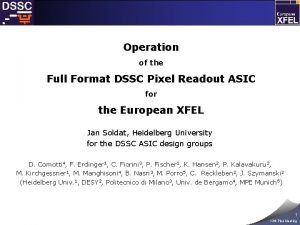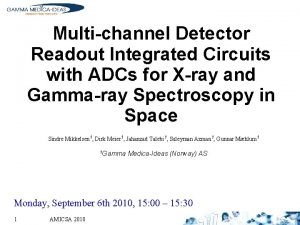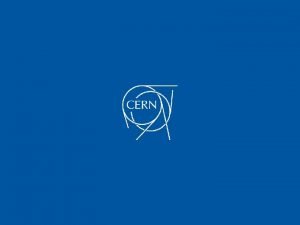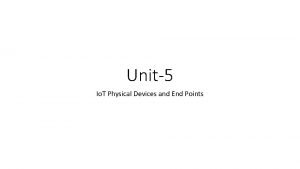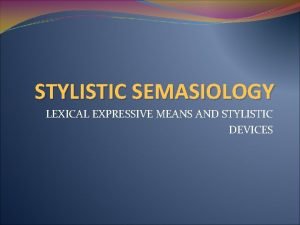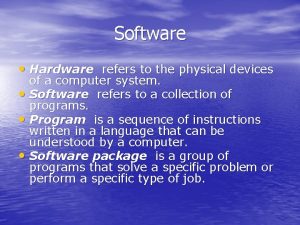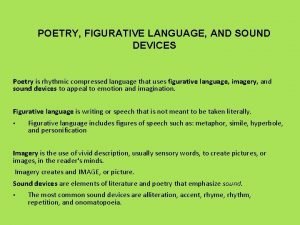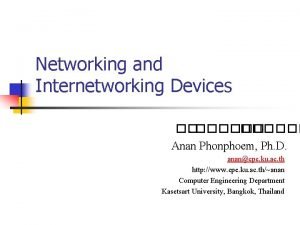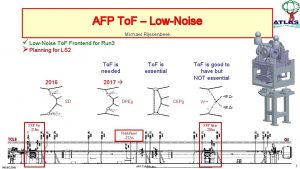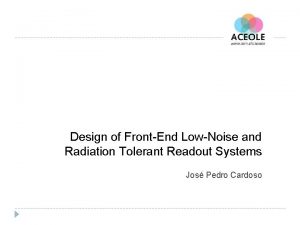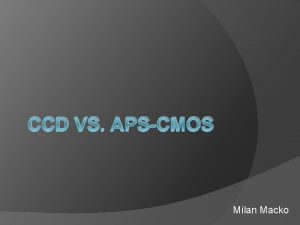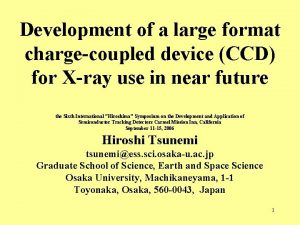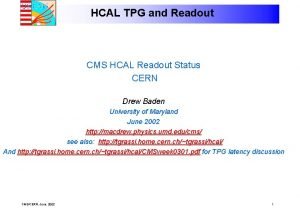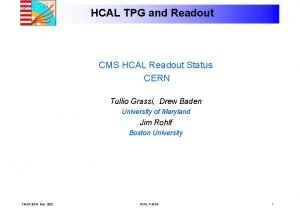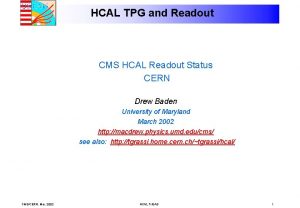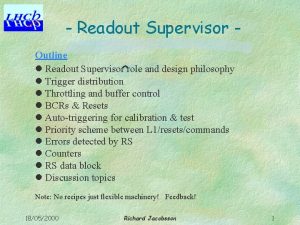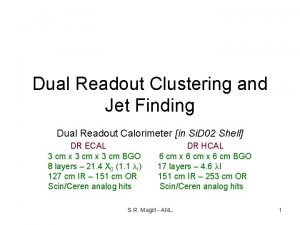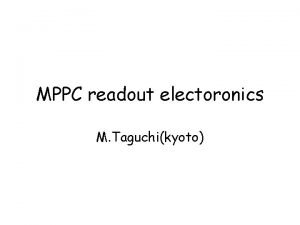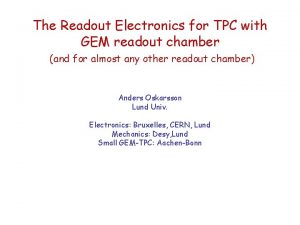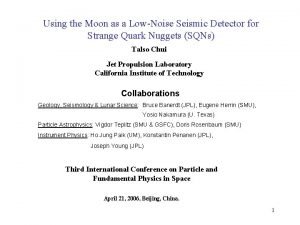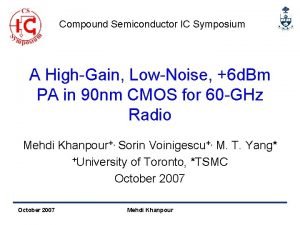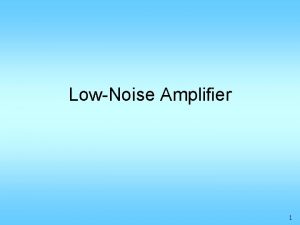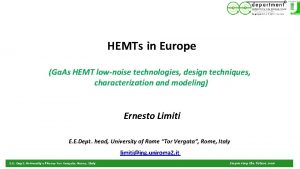OrthogonalTransfer ChargeCoupled Devices and LowNoise ChargeCoupled Devices Readout




















- Slides: 20

Orthogonal-Transfer Charge-Coupled Devices and Low-Noise Charge-Coupled Devices Readout Circuits* Barry E. Burke *The MIT Lincoln Laboratory portion of this work was performed under a Collaboration Agreement between MIT Lincoln Laboratory and The University of Hawaii, Institute for Astronomy (If. A). Opinions, interpretations, conclusions, and recommendations are those of the authors, and do not necessarily represent the view of the United States Government. MIT Lincoln Laboratory RIDL visit-1 BEB 11/22/2020

Outline • Review of Orthogonal-Transfer Charge. Coupled Devices (OTCCD) • Development of the orthogonal transfer array (OTA) • Low-noise CCD readout circuits • Summary RIDL visit-2 BEB 11/22/2020 MIT Lincoln Laboratory

Conventional vs. Orthogonal-Transfer CCDs RIDL visit-3 BEB 11/22/2020 MIT Lincoln Laboratory

Application Areas • Compensation of platform motion – Imaging from unstable and/or moving platforms – TDI (time delay and integrate) with variable scan direction • Compensation of scene motion Video out Frame store Output register Imaging area – Ground-based astronomy OTCCD can noiselessly compensate for scene motion across sensor during image integration RIDL visit-4 BEB 11/22/2020 MIT Lincoln Laboratory

Application of OTCCDs in Astronomy Star-cluster imagery (M 71) • Use OTCCD to remove blurring due random motion of star images (electronic tip-tilt) No motion compensation, =0. 73" With motion compensation, =0. 50” SNR increase: 1. 7 RIDL visit-5 BEB 11/22/2020 MIT Lincoln Laboratory

Outline • Review of Orthogonal-Transfer Charge. Coupled Devices (OTCCD) • Development of the orthogonal transfer array (OTA) • Low-noise CCD readout circuits • Summary RIDL visit-6 BEB 11/22/2020 MIT Lincoln Laboratory

Pan-STARRS (Panoramic Survey Telescope and Rapid Response System) • Four 1. 8 -m telescopes viewing same sky sector – 3˚ FOV, 24 mv sensitivity – High-cadence, wide-field surveys – Detect variable or moving objects • 1. 4 -Gpixel CCD focal-plane array on each telescope Proposed Pan-STARRS telescope configuration RIDL visit-7 BEB 11/22/2020 Gigapixel focal-plane array (64 CCDs) First Pan-STARRS telescope on Haleakala (PS 1) MIT Lincoln Laboratory

Orthogonal-Transfer Array 2. 38 arc min • Wide field-of-view (FOV) imaging – Wavefront tilt decorrelates over FOV > few arc minutes – Need 2 D array of OTCCDs, each independently clocked to track local wavefront tilt (“rubber focal plane”) • OTA is a new CCD architecture – Requires on-chip switching logic – More complex layout and processing than conventional CCDs RIDL visit-8 BEB 11/22/2020 MIT Lincoln Laboratory

Orthogonal Transfer Array OTA: 8 8 array of OTCCD cells OTA cell with I/O control Four-phase OTCCD pixels • New device paradigm – 2 D array of independent OTCCDs – Independent clocking and readout of OTCCDs • Advantages – Enables spatially varying tip-tilt correction – Isolated defective cells tolerable (higher yield) RIDL visit-9 BEB 11/22/2020 MIT Lincoln Laboratory

OTA Operation • Subset (4 – 5) of cells chosen to image guide stars • Map of wavefront tilt constructed from guide-star data and applied to science cells • Four redundant views of every patch of sky used to fill gaps due to – – RIDL visit-10 BEB 11/22/2020 Guide-star cells Dead cells Cosmic rays Dead areas between cells and devices MIT Lincoln Laboratory

Device Fabrication • Four OTAs on 150 -mm wafer (die size 49. 5 50. 1 mm) • Four-poly, n-buried-channel process • Fabricated on 5 000 Ω·cm floatzone silicon wafers • Back-illuminated devices thinned to 75 µm 150 -mm wafer with four OTAs Photo of pixel array RIDL visit-11 BEB 11/22/2020 MIT Lincoln Laboratory

Sample Imagery • First devices were fully functional but with some issues (noise, logic “glow”) • Device redesign resolved issues with prototype devices • Redesigned devices have been fabricated and most of them packaged Image from OTA cell with fixed light spot and CCD gates clocked RIDL visit-12 BEB 11/22/2020 Image from back-illuminated OTA 10 -µm pixel, 22. 6 Mpixels MIT Lincoln Laboratory

Substrate Bias • Substrate bias enables thick, fully depleted devices: – High quantum efficiency, 800 -1000 nm – Small charge point-spread function RIDL visit-13 BEB 11/22/2020 MIT Lincoln Laboratory

Quantum Efficiency • Back-surface p+ using ion-implant/laser anneal • Two-layer anti-reflection coating with reflection null at 850 nm for reduced fringing • Thicker device clearly superior beyond 800 nm RIDL visit-14 BEB 11/22/2020 MIT Lincoln Laboratory

OTA Focal Planes • TC 3 focal plane assembled from 16 prototype devices; on-sky tests in February • GPC 1 assembled from lots 2 and 3 (summer 2007) RIDL visit-15 BEB 11/22/2020 MIT Lincoln Laboratory

Outline • Review of Orthogonal-Transfer Charge. Coupled Devices (OTCCD) • Development of the orthogonal transfer array (OTA) • Low-noise CCD readout circuits • Summary RIDL visit-16 BEB 11/22/2020 MIT Lincoln Laboratory

CCD Output Circuits RIDL visit-17 BEB 11/22/2020 MIT Lincoln Laboratory

Output Circuit Comparison Sense-node capacitance is lower ( higher responsivity) for JFET than MOSFET RIDL visit-18 BEB 11/22/2020 Noise spectral voltage is lower for JFET than MOSFET MIT Lincoln Laboratory

Noise Comparison Best MOSFET noise vs. preliminary JFET noise RIDL visit-19 BEB 11/22/2020 2000 -fps, 160 -pixel imager, 20 ports with JFET output circuits MIT Lincoln Laboratory

Summary • OTCCD developed for astronomical applications but has a potentially much broader range of uses • OTA development for Pan-STARRS is new OTCCD concept, also with other applications • Recent work with JFETs shows noise levels better than BCMOSFETs and nearing 1 e- RIDL visit-20 BEB 11/22/2020 MIT Lincoln Laboratory
 Readout device
Readout device Full pixel readout
Full pixel readout Readout integrated circuit
Readout integrated circuit Readout units
Readout units 4 literary elements
4 literary elements Input or output devices of computer
Input or output devices of computer Input device
Input device Computer graphics
Computer graphics Input devices for vr
Input devices for vr Physical devices of a computer
Physical devices of a computer Stylistic semasiology deals with
Stylistic semasiology deals with Physical devices of a computer
Physical devices of a computer Act 4 scene 4 romeo and juliet summary
Act 4 scene 4 romeo and juliet summary Pride and prejudice chapter 16 summary
Pride and prejudice chapter 16 summary What is a sound device in poetry
What is a sound device in poetry What is output
What is output Of mice and men chapter 3 notes
Of mice and men chapter 3 notes Networking and internetworking devices
Networking and internetworking devices Literary devices in romeo and juliet
Literary devices in romeo and juliet Romeo and juliet literary devices
Romeo and juliet literary devices Lexical expressive means and stylistic devices
Lexical expressive means and stylistic devices

